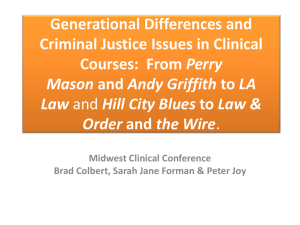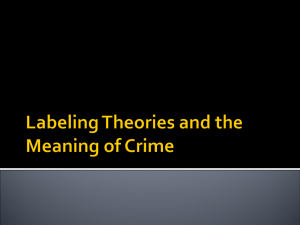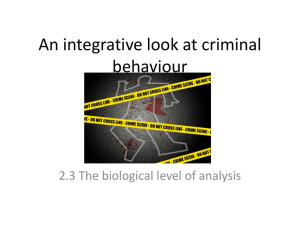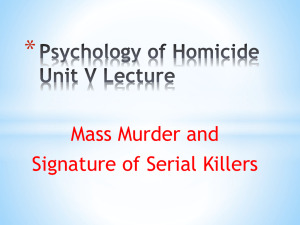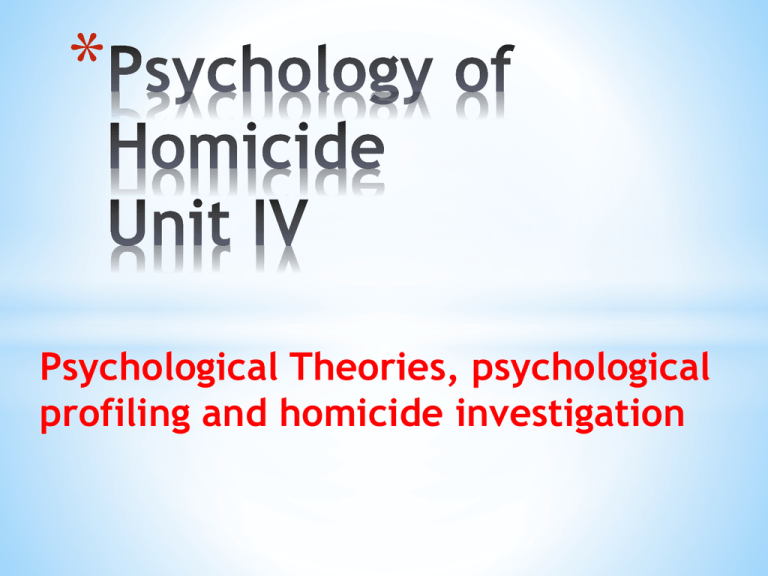
*
Psychological Theories, psychological
profiling and homicide investigation
*
*Defined as-is an approach to
understanding the criminal behavior of
individuals. It involves the ethical
application of psychological knowledge
and methods to the practical tasks of
predicting and influencing the likelihood
of criminal behavior, and the reduction of
the human and social costs associated
with crime.
*
*Criminal behavior legally is defined as
actions that are prohibited by state
and federal laws.
*Criminal behavior psychologically
defined is actions that may be
rewarding to the actor (criminal) but
inflicts pain or loss on others, criminal
behavior is antisocial behavior.
*
*Bad in itself-give examples
*Prohibited by law-give
examples
*
*Lower class origins
*Personal distress/psychopathology
*Family structure/parent problems
*Minor personality variables
*Poor parent-child relations
*Personal educational/vocational
achievement
*Temperament/weak self-control/misconduct
history
*Antisocial attitudes/associates
*
*Antisocial personality
pattern
*History of antisocial
behavior
*Antisocial attitudes
*Antisocial associates
*
*Children and then adults learn
criminal behavior, this may
include a lack of behavioral
self-control, modeling and
learning by observation.
*
*This is a framework of
the majority of elements
of current psychological
research on aggression
and criminality.
Variable associated with criminal violence are;
*
Instigation to aggression (A): The sum of all internal
motivators. Some examples of personal gain are
money, anger, and jealousy.
*Habit strength (H): Behavioral preferences learned
through rewarded experience and observation.
*Inhibitions against aggression (I): The sum of all
internal factors opposing an aggressive act, such as
conditioned fear of punishment, learned attitudes and
values, and identification with the victim.
*Stimulus factors in the immediate environment that
may facilitate (S) or inhibit (S) violence.
*
*Response competition: Other possible
responses are subject to their own algebra,
and nonaggressive responses may have a
more favorable cost-benefit ratio than the
aggressive response. (Insert equation below)
*
*Sykes and Matza theory of the
cognition of crime. This theory is
called “Techniques of Neutraliztion”
and here are the ways people
neutralize or rationalize illegal actions
*
*Denial of responsibility-I couldn’t help it.
I have a
strong sex drive. I couldn’t control myself.
*Denial of injury-I didn’t hurt anybody. We just took
the car for a ride.
*Denial of victim-he had it coming to him. She got
what she deserved for being a disobedient wife.
*Condemnation of the condemners-criminal blame
the system, lawyers are corrupt, judges can be
bought, and police are brutal and corrupt too.
*Appeal to a higher loyalty-I did this for a friend, not
myself. This is what God would want.
Biological Theory of Crime
* Heredity and crime-twin studies, adoption studies and
neurological defects
* Twin studies and adoption studies indicate there is a genetic
component to criminal behavior. It may be more temperamental
characteristics that are inherited that actual criminal behavior
per se.
* Traumatic injuries to the brain, hormonal imbalances and other
neurobiological disturbances have been documented as factors in
the criminal behavior of some individuals.
* Evolutionary explanations have mixed results and highly
controversial.
Anti-personality pattern
• Personality tries to answer the
question, “who am I”? Personality
studies deal with studying traits,
some traits associated with criminal
behavior are; aggressivity,
impulsiveness, risk taking, dishonesty,
and emotional negativity.
*
*Neuroticism-anxious, angry hostility, impulsive
*Extraversion-sociable, positive emotions,
excitement seeking
*Openness to experience-creative, open-minded,
intelligent
*Agreeableness-trustworthy, altruistic, compliant
*Conscientiousness-competent, orderly, selfdisciplined
*
*A classification system or taxonomy of
mental disorders published by the
American Psychiatric Association. This
classification system describes behavioral
patterns and psychological characteristics
that are clustered into diagnostic
categories. The personality disorders
include;
*
*Obsessive-compulsive personality
*Paranoid Personality disorder
*Narcissistic personality
*Antisocial personality disorder
(APD)
*
* DSM-IV Criteria for APD
1.
Disregard for the rights of others. At least 3 of the following:
* Behaves in a way this is grounds for arrest
* Deceitful and manipulative
* Impulsive
* Aggressive
* Irresponsible
* Lack of remorse
2.
3.
4.
Age 18 or more
A history of childhood conduct disorder
Antisocial behavior not a product of schizophrenic/manic
episode.
Three important points about psychopathy;
*Psychopaths have all the outward
appearances of normality. They do not
have hallucinations or delusions.
*Psychopaths appear unresponsive to social
control. They continue to get in trouble
even after punishment.
*Criminal behavior is not a necessary
requirement for the diagnosis of
psychopathy.
*
*Manipulative
*Superficial charm
*Above average intelligence
*Absence of psychotic symptoms (delusions, hallucinations)
*Absence of anxiety
*Lack of remorse
*Failure to learn from experience
*Egocentric
*Lacks emotional depth
*
*Trivial sex life
*Unreliable
*Failure to follow a life plan
*Untruthful
*Suicide attempts rarely genuine
*Impulsive
*Antisocial behavior
*
*The FBI has divided offenders into two distinct profiles
based on hundreds of interviews with known and
incarcerated murderers and serial criminals. These
categories are powerful and sophisticated tools based on
years of profiling violent offenders.
*Profiling is based on the premise that offender’s
personalities and motivations are revealed in the specific
nature and characteristics of their criminal behavior.
This behavior can be analyzed by the crime scene and
victims they leave behind.
*
Organized Killers
Disorganized Killers
Average to above intelligence
Below average intelligence
Socially competent
Socially inadequate
Skilled work preferred
Unskilled work
Sexually competent
Sexually incompetent
High birth order status
Low birth order status
Father’s work stable
Father’s work unstable
Inconsistent childhood discipline
Harsh discipline as a child
Controlled mood during crime
Anxious mood during crime
Use of alcohol with crime
Minimal use of alcohol with crime
Precipitating situational stress
Minimal situational stress
Living with partner
Living alone
Mobility with car in good condition
Lives/works near crime scenes
Follows crime in the media
Minimal interest in the media
May change jobs or leave area
Significant behavioral change (drug or alcohol use)
*
*The weapon used in 51% or more of
homicides is the handgun (automatic
or revolver), 14% with other type guns
(rifle or shotgun), and 13% with knives
or other sharp instruments.
****Most homicides are committed on
Saturday.
*
*Three basic types of homicide
1. Excusable homicide-these are
accidental or unintentional killings. To
be excusable it must be shown the
killers did not act with negligence
(example-a driver kills a pedestrian
that walks out in front of the car, with
no negligence on the part of the
driver.)
*
*Justifiable homicide-these are killings
judged to be acceptable because they
occurred in defense of life or property,
this type of homicide is out of necessity.
There are two types; those by officers and
those by private citizens in defense
primarily of life.
*
* Criminal homicide-these murders are illegal killings and can be
classified into different hierarchical categories.
* First degree murder-are committed with premeditation and deliberation.
Punishment typically is life in prison or the death penalty.
* Second degree murder-are committed without premeditation and are
typically spur of the moments killings. This type person kill because they
exhibit extreme indifference for the life of another and intend serious
injury. Punishment is typically prison orlife in prison, sometimes with the
possibility of parole.
* Felony murder-a killing that occurs during the commission of another
felony, such as a robbery. In most jurisdictions the felony must be a
violent one. Felony murders are one of the common ways a person is sent
to death row.
*
Homicide
Justifiable
Citizen
Excusable
Police
Criminal Homicide
Manslaughter
Murder
First Degree
Murder
(premeditated)
Second Degree
Murder
Felony Murder
*
*Mass Murder
*Spree Murder
*Serial Murder
*
*Mass murder-someone who kills four or
more victims in one location in one
incident. The killings are all part of the
same emotional experience. Mass
murderers often kill themselves after they
have completed their deadly rampage.
Most offenders are white males, middle
age, frustrated and very angry.
*
*Mass murder typically takes place in one of three
locations;
*1) the home
*2) the workplace and
*3) the school.
*
Murder is the second leading cause of death in the workplace.
Murders in schools are typically committed by students who fell
“picked on” by other students “bullying” and these student
offenders typically suffer from depression, anger and
frustration.
*
*When someone murders at two or more
separate locations, but with no emotional
cooling off period between homicides. This is
the least common of the 3 types of Multicide;
this type of killing is also called a “binge of
killing and destruction.” The trigger for spree
killers can be fairly minor, but once the spree
killer begins the killing typically only stops when
they are killed, captured or they commit
suicide, an example is Andrew Cunanan
*
*Someone who has murdered on at
least 3 occasions, with what can be
called a cooling-off period between
each incident. This cooling off period
can be days, weeks, months or even
years. Each event is emotionally
distinct and separate.
*
•
In serial murder there is no prior relationship between
victim and attacker, the motives are normally for
dominance and power over the victim. Subsequent
murders are sometimes at different times and have no
connection to the initial murder. Typically victims are
vagrants, prostitutes, homeless people, and migrant
workers, homosexuals, missing children, single women
(out by themselves), elderly women, college student
and hospital patients. Current research suggests that
during the year on average around 35 serial killers are
active. Most are white men, in their 20-30 years old.
*
• Research on the commonality of
serial killers suggest a homicidal
triad which is; bed wetting past an
appropriate age, cruelty to animals
and fire setting. Many past serial
killers have demonstrated at least
two of these commonalities.
*
Bed Wetting at
inappropriate age
Animal
Cruelty
Fire setting
*
* Hedonistic lust killer-motive is to obtain sexual pleasure from
the killing, while alive or dead, or by mutilating or cutting
off sexual organs (Jerry Brudos).
* The thrill killer-these killers are also hedonistic but derive
sexual satisfaction but require a live victim for sexual
satisfaction. These killers receive gratification from
torturing, dominating, terrorizing and humiliating their
victims while alive (Kenneth Bianchi and Angelo Buono).
* The comfort killer-this is the last type hedonistic serial killer,
this killer does so for creature comforts, such as financial
gain (Fay and Ray Copeland).
*
* The power/control killer-the motive for this killer is domination
and total control of the victim, sometimes sex is involved, the
primary pleasure is from complete control over the victim (Ted
Bundy).
* The mission killer-this killer is on a mission to rid the world of
this type person or group of persons seen as inferior in some
way. This killer restricts his victims to only those in the group
(Joel Rifkin).
* The visionary killer-this is the least common, this killer has a
break with reality. The killer is driven by voices or images that
command them to kill, they may have multiple personalities
(Joseph Kallinger).
*
*
*Thank you!







